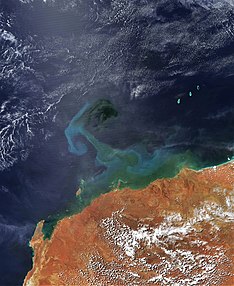This article's use of external links may not follow Wikipedia's policies or guidelines. (July 2018) |

Hydrobiology is the science of life and life processes in water. Much of modern hydrobiology can be viewed as a sub-discipline of ecology but the sphere of hydrobiology includes taxonomy, economic and industrial biology, morphology, and physiology. The one distinguishing aspect is that all fields relate to aquatic organisms. Most work is related to limnology and can be divided into lotic system ecology (flowing waters) and lentic system ecology (still waters).
One of the significant areas of current research is eutrophication. Special attention is paid to biotic interactions in plankton assemblage including the microbial loop, the mechanism of influencing algal blooms, phosphorus load, and lake turnover. Another subject of research is the acidification of mountain lakes.[1][2] Long-term studies are carried out on changes in the ionic composition of the water of rivers,[3] lakes and reservoirs in connection with acid rain and fertilization. One goal of current research is elucidation of the basic environmental functions of the ecosystem in reservoirs,[4] which are important for water quality management and water supply.

Much of the early work of hydrobiologists concentrated on the biological processes utilized in sewage treatment and water purification especially slow sand filters. Other historically important work sought to provide biotic indices for classifying waters according to the biotic communities that they supported. This work continues to this day in Europe in the development of classification tools for assessing water bodies for the EU water framework directive.[5]
A hydrobiologist technician conducts field analysis for hydrobiology. They identify plants and living species, locate their habitat, and count them. They also identify pollutants and nuisances that can affect the aquatic fauna and flora. They take the samples and write reports of their observations for publications.
A hydrobiologist engineer intervenes more in the process of the study. They define the intervention protocols and what samples should be taken. They plan and program the study campaigns, and then summarize their results. In the event of pollution, they propose solutions to improve the biological quality of water within the framework of the regulations in force. In the case of complex programs, hydrobiologists can work in a multidisciplinary team with botanists and zoologists.
The hydrobiologist works on behalf of large public institutions of a scientific and technological nature (CNRS, INRA, IRD, CIRAD, IRSTEA ...), public institutions (Water Agencies, Regional Directorates environment, Higher Council of Fisheries, CEMAGREF ...), companies (EDF, Veolia environment, Suez environment, Saur, ...), local authorities, research departments, and associations (Federations of fishing, Permanent Centers for Environmental Initiatives ...).
- ^ Kopáček, Jiří; Kaňa, Jiří; Bičárová, Svetlana; Brahney, Janice; Navrátil, Tomáš; Norton, Stephen A.; Porcal, Petr; Stuchlík, Evžen (2019-09-06). "Climate change accelerates recovery of the Tatra Mountain lakes from acidification and increases their nutrient and chlorophyll a concentrations". Aquatic Sciences. 81 (4): 70. Bibcode:2019AqSci..81...70K. doi:10.1007/s00027-019-0667-7. ISSN 1420-9055. S2CID 201848799.
- ^ Beamish, Richard J.; Harvey, Harold H. (2011-04-13). "Acidification of the La Cloche Mountain Lakes, Ontario, and Resulting Fish Mortalities". Journal of the Fisheries Board of Canada. 29 (8): 1131–1143. doi:10.1139/f72-169.
- ^ Qu, Bin; Zhang, Yulan; Kang, Shichang; Sillanpää, Mika (2019-02-01). "Water quality in the Tibetan Plateau: Major ions and trace elements in rivers of the "Water Tower of Asia"". Science of the Total Environment. 649: 571–581. Bibcode:2019ScTEn.649..571Q. doi:10.1016/j.scitotenv.2018.08.316. ISSN 0048-9697. PMID 30176468. S2CID 52169676.
- ^ Galizia Tundisi, José (2018-08-01). "Reservoirs: New challenges for ecosystem studies and environmental management". Water Security. 4–5: 1–7. Bibcode:2018WatSe...4....1G. doi:10.1016/j.wasec.2018.09.001. ISSN 2468-3124. S2CID 240294270.
- ^ "Introduction to the EU Water Framework Directive - Environment - European Commission". ec.europa.eu. Retrieved 2022-03-01.